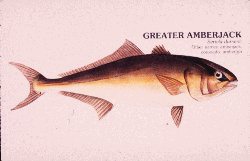Greater Amberjack (Seriola dumerili)

TPWD ©
- Other Names
- Amberjack, Coronado, Amberfish
- Description
- Regulated nongame species - see bag & size limits
Greater amberjack is a large reef fish found in the Gulf. It is the largest and most common amberjack that lives along the coast.More slender than most jacks, they do not have finlets and the keel at the base of the tails is slight and soft. The back is bluish purple, the sides yellowish and the underside silver. Amberjacks have a distinctive dark band on the sides of the head which angles from the front of the back fin, through the eye to the mouth. The tail fin is lunate or moon-shaped.
Although they average about 20 pounds, they can weight in at more than 170 pounds. The Texas record is 115 bounds and 66.5 inches; 1994. - Life History
- Food consists of other smaller reef fish. Small jacks may congregate, but larger fish are often solitary. Larger fish are also usually females, because they tend to live much longer than males (up to 15 years). Spawning occurs offshore and begins at about 2 to 3 years of age.
- Habitat
- Greater Amberjacks live primarily near structure such as artificial reefs and oil rigs in Texas waters.
- Distribution
- Amberjacks are found through the tropical and temperate Atlantic Ocean, including the Gulf of Mexico.
- How To Catch
- Fish are often caught incidental to red snapper around offshore oil rigs and artificial reefs. They can be caught with large hooks on cut bait or using fish, especially ribbonfish, for bait.
- Where To Catch
- Are easiest to catch around artificial reefs or oil rigs in Texas waters.
- How To Eat
- Amberjacks are edible, but generally not a preferred eating fish.